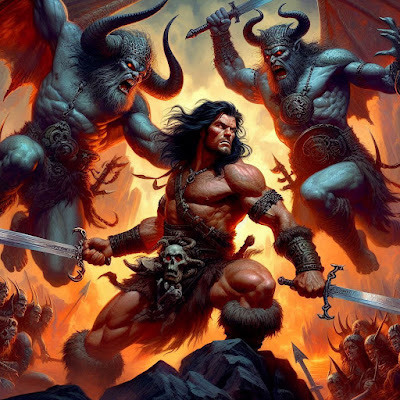KN Mil 3.7.6 Ven. Nāgasena says about the sword of samādhi: "It don't mean a thing, if it ain't got that swing!"
Ven. Nāgasena says about the sword of samādhi: "It don't mean a thing, if it ain't got that swing!"
KN Mil 3.7.6. awakening factors 6. Bojjhaṅga-pañha
6. Bojjhaṅga-pañha | 3.7.6. awakening factors |
Rājā āha—“kati nu kho, bhante nāgasena, bojjhaṅgā”ti? | The king said: ‘Venerable Nāgasena, how many awakening factors are there?’ |
“Satta kho, mahārāja, bojjhaṅgā”ti. | ‘Seven, O king.’ |
“Katihi pana, bhante, bojjhaṅgehi bujjhatī”ti? | ‘And by how many kinds of awakening does one awaken?’ |
“Ekena kho, mahārāja, bojjhaṅgena bujjhati dhamma-vicaya-sambojjhaṅgenā”ti. | ‘By one: that is to say by the awakening factor called “the Dharma investigation awakening factor.”’ |
“Atha kissa nu kho, bhante, vuccanti ‘satta bojjhaṅgā’”ti? | ‘Then why is it said there are seven?’ |
“Taṃ kiṃ maññasi, mahārāja, asi kosiyā pakkhitto aggahito hatthena ussahati chejjaṃ chinditun”ti. | ‘Tell me, O king. Suppose a sword were lying in its sheath and not taken in the hand, could it cut off anything you wanted to cut off with it?’ |
“Na hi, bhante”ti. | ‘Certainly not.’ |
“Evameva kho, mahārāja, dhamma-vicaya-sambojjhaṅgena vinā chahi bojjhaṅgehi na bujjhatī”ti. | ‘Just so, great king, by the other kinds of wisdom can nothing be understood without investigation of the Dharma.’ |
“Kallosi, bhante nāgasenā”ti. | ‘Very good, Nāgasena!’ |
Visuddhi-magga and Ajahn Brahm eliminate the sword swinging from the 4 jhānas
Whereas in the EBT early buddhist texts, the samadhi awakening factor, which corresponds to the 4 jhanas, contain a symbiotic balance between samatha and vipassana, via the Dhamma vicaya (Dharma instruction investigation) and upekkha (equanimous-observation),
Vism. and Ajahn Brahm turn the 4 jhanas into an exercise of pure samatha fetish.
Instead of an organic, holistic and harmonized approach to sharpening the sword of samadhi and going into battle trying to chop Mara's head off, i.e. developing samatha and vipassana in a balanced way, Vism. encourages an alternate approach of mastering samatha (which can take many years, and ardent and dedicated followers mostly still fail, just one in a million succeed), and delaying vipassana until after one masters samatha.
This ostensible act of attempting to master samatha, results in most of these dedicated followers just spending much of their days for many years, sharpening the sword, stroking and stroking and stroking the blade, never taking the sword into battle with the defilements as the Buddha instructed in the EBT seven awakening factors.
"It don't mean a thing, if it ain't got that swing!"
Don't spend all day stroking that blade trying to be the master of samatha.




Comments
Post a Comment